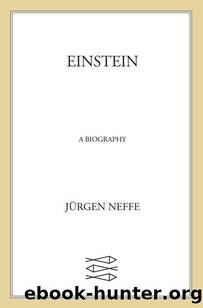Einstein: A Biography by Jürgen Neffe

Author:Jürgen Neffe [Neffe, Jürgen]
Language: eng
Format: epub
Publisher: Farrar, Straus and Giroux
Published: 2007-04-17T04:30:00+00:00
TWELVE
LAMBDA LIVES
EINSTEIN, “CHIEF ENGINEER
OF THE UNIVERSE”
Einstein did not need to look up a single time to explore every last detail of the universe, but the rest of us have to supplement the power of the mind with telescopes, antennas, and satellites in our quest to see beyond the range of human travel.
The road to the stars is steep. The outlines of cubes and cupolas can be made out behind a curve. “Turn out the light,” says the man. “Any artificial lighting will interfere with our work.” The world is instantly enveloped in blackness, with the stars close enough to pluck, yet farther than the eye can see. There are hundreds of billions in every one of the hundreds of millions of galaxies—the cosmos, the greatest possible negation of nothingness. Somewhere in one of these dots, called the Milky Way, on a planet that circles around one of the countless suns, John Beckman, a professor of astronomy, is following his idol, Albert Einstein, to the end of the world and to the beginning of time. Alpha and omega, united in the field equations of spacetime and gravitation.
“The farther we look into the cosmos, the deeper we see into the past,” says the professor when he reaches his workplace: the Observatorio del Teide, the highest astronomical observatory in Europe, on the Canary Island of Tenerife. Domes, houses, and cabins, snow-white by day, silky gray by night. In the pale light, the ensemble, surrounded by solidified lava, looks like a human frontier settlement on the moon or Mars. On the horizon, the peaks of the Teide volcano rise 3,770 meters, making it the highest mountain in Spain.
Beckman talks in terms of light years, billions of light years. This concept is mind-boggling, yet he throws it into the conversation the way others might say “two dozen eggs” or “seven yards of fabric.” No sooner has he sat down in one of the heated cabins than this British man in his late fifties, who is employed by the Spanish government, begins to talk, aflutter with excitement, about the beginnings of modern cosmology and about Einstein’s legacy, about predictions and confirmations, instinct and error, and the kind of astronomy he and his colleagues research today. They consider the “chief engineer of the universe,” as a letter writer once called Einstein, the prophet of their guild.
One of the first words John learned to say as a little boy was “telescope.” He began observing the visible stars at the age of four. By the time he was ten, he knew the sky like the back of his hand, and by the age of fifteen he could “read” the firmament like a map of the galaxies. When he studied physics, however, he was one of the very few to dream of becoming an astronomer like Copernicus, Kepler, Eddington, and Freundlich.
“After World War II, hardly anyone was looking up at the sky,” Beckman said. Entire generations of physicists turned away from astronomy—and from the general theory of relativity. The land of the giants was no longer one of their goals of choice.
Download
This site does not store any files on its server. We only index and link to content provided by other sites. Please contact the content providers to delete copyright contents if any and email us, we'll remove relevant links or contents immediately.
Hit Refresh by Satya Nadella(8338)
When Breath Becomes Air by Paul Kalanithi(7264)
The Girl Without a Voice by Casey Watson(7263)
Do No Harm Stories of Life, Death and Brain Surgery by Henry Marsh(6337)
A Court of Wings and Ruin by Sarah J. Maas(6076)
Hunger by Roxane Gay(4219)
Shoe Dog by Phil Knight(4169)
Everything Happens for a Reason by Kate Bowler(4067)
A Higher Loyalty: Truth, Lies, and Leadership by James Comey(4033)
The Rules Do Not Apply by Ariel Levy(3906)
Tuesdays with Morrie by Mitch Albom(3832)
The Immortal Life of Henrietta Lacks by Rebecca Skloot(3826)
How to Change Your Mind by Michael Pollan(3679)
Millionaire: The Philanderer, Gambler, and Duelist Who Invented Modern Finance by Janet Gleeson(3569)
All Creatures Great and Small by James Herriot(3517)
Elon Musk by Ashlee Vance(3455)
Tokyo Vice: An American Reporter on the Police Beat in Japan by Jake Adelstein(3440)
Man and His Symbols by Carl Gustav Jung(3315)
The Money Culture by Michael Lewis(3284)
